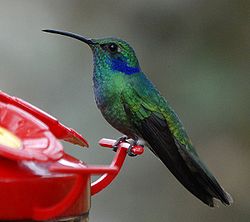Distribution and habitat
Distribution
The Mexican violetear breeds from the highlands of southern Mexico south to Nicaragua. It is a rare but annual nonbreeding visitor to the United States, primarily southern and central Texas, with scattered records as far north as extreme southern Canada. [5] According to IUCN C. thalissinus can be found in much of montane areas of the northern Andes, stretching from Bolivia to Venezuela. [6]
Habitat
Common habitats for the Mexican violetear is in the canopy and borders of subtropical and lower temperate forest, secondary woodland and scrub, and clearings and gardens in the subtropical zone. It is recorded mostly between altitudes of 1,200 to 2,300 m (3,900 to 7,500 ft), though they will sometimes wander as far down as 500 m (1,600 ft) in search of food sources. It generally prefers more humid and high-altitude areas, such as cloud forests.
Diet
The Mexican violetear forages alone but tends to gather at flowering trees, especially coffee-shade Inga . They feed at mid-level to canopy and often hold and defend a feeding territory. They primarily feed on nectar and small insects. They are a fairly common species that thrives in deforested areas.
Breeding
Like most hummingbirds, the Mexican violetear is a solitary nester. The male's only involvement in the breeding process is to attract and mate with the female. The female is then responsible for choosing a nest location, generally on a low, small horizontal branch in a protected area. The nest is small and built from various plant materials, spider webs, and down woven together to form a sturdy cup structure. Two small white eggs are laid within the nest and the female incubates them on her own. Incubation time is 14–18 days. Hatchlings are primarily fed insects due to high nutritional requirements. No information was found on the length of the nestling stage or age at fledgling. Breeding takes place though the wet season into the early dry season, which varies by latitude. [7]
Migration
Seasonal movements of the Mexican violetear are not well understood. Many individuals of northern populations move south or and/or to lower elevations following the end of the breeding season (July to November in Mexico), but regular occurrence hundreds of kilometres north of this range suggests a more complex migration strategy. [5] [7]
This page is based on this
Wikipedia article Text is available under the
CC BY-SA 4.0 license; additional terms may apply.
Images, videos and audio are available under their respective licenses.


